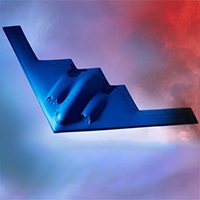
In this case study, the 509th Maintenance Group of the U.S. Air Force used an eight-step continuous process improvement approach to balance its resources and meet both flying hour program requirements and aircraft availability needs. This week looks at steps 1 through 4. Part 2 looks at steps 5 through 8.
Introduction
The B-2 bomber is one of the most sophisticated, technologically advanced weapons systems in the world and the technicians who maintain it require the best processes available to ensure the B-2 is ready to execute its mission – nuclear deterrence. A major point of emphasis with the B-2 is the coatings applied to the skin of the aircraft. Low observable (LO) maintenance – that is, keeping up the stealth signature of the aircraft – requires significant manpower and man-hour requirements. To ensure efficiency and effectiveness within the process of LO maintenance, the 509th Maintenance Group (MXG) held a continuous process improvement (CPI) event to stand up the LO production machine. The LO machine is the culmination of months of hard work and research by a team of subject matter experts and key decision makers within the maintenance complex. This article will discuss the problems with previous processes, the need for an LO production machine, the road to goal, the CPI event, and action plan implementation.
Acronyms
- AA, aircraft availability
- AFSC, Air Force Sustainment Center
- BW, Bomb Wing
- COA, course of action
- CPI, continuous process improvement
- FHP, flying hour program
- HPO, hourly post flight
- LO, low observable
- LOPM, low observable production machine
- MXG, Maintenance Group
- PDM, programmed depot maintenance
- SME, subject matter experts
The B-2 LO flight is one of the largest and most complex entities within the United States Air Force aircraft maintenance community. More than 250 airmen, Department of Defense civilians and contractors perform scheduled and unscheduled LO maintenance on 20 assigned B-2 aircraft. Perhaps the largest issue performing maintenance on these aircraft is the unpredictability within the aircraft scheduling and manpower distribution. There is a vast array of jobs to be performed on almost every square inch of the external skin of the aircraft with the biggest concern being heavy restoration projects. These heavy maintenance actions require the aircraft to be down for extended amounts of time while restoring them back to pristine LO conditions.
Maintaining all 20 B-2 aircraft in pristine condition is a task that would be easily obtainable if the B-2 wasn’t dual hatted. When planning maintenance for the B-2, the 509th Bomb Wing (BW) organization must consider two major driving factors: the annual flying hour program (FHP) – which comprises the number of hours needed to attain and maintain combat readiness and capability for its aircrews, to test weapon systems and tactics, and to fulfill collateral requirements such as air shows – and wartime posture for projecting nuclear deterrence. The 509th BW’s mission is to have a fleet of aircraft and flight crews ready to meet strategic objectives, but also has to train those crews so they are ready when called upon. To do so, it must find the appropriate balance of war readiness posturing to meet global mission demands while simultaneously meeting annual flying hour objectives. They don’t have the luxury of tipping the scales in one area over the other.
To appropriately balance resources and meet both the FHP requirements and wartime posture, the 509th BW has to balance aircraft availability (AA) to the utmost of its abilities. To accomplish this seemingly unachievable task, a production machine was developed specifically targeting the heavy LO restoration process. The production machine provides an element of predictability within the LO restoration and scheduling process while also meeting both the FHP and wartime posture. The production machine concept was borrowed from the Air Force Sustainment Center (AFSC), specifically its 2015 foundational text The Art of the Possible. Paramount to the development of a production machine is a theory known as Little’s Law.
Unpredictability in the Process and Application of Little’s Law
The B-2 bomber has been stationed at Whiteman AFB for more than 20 years and the heavy LO restoration process has remained the same since inception. For decades, maintainers used the 200-flying hour hourly post flight (HPO) inspection as the trigger point for induction into heavy LO restoration. This was viewed as an opportunity as the inspection requires an aircraft to remain down for several days and provided a simple mechanism to schedule restoration. Depending on operational tempo, however, the HPO scheduling method provided situations in which some aircraft flew 200 hours in a few weeks while others took six months or longer. This unpredictability caused forecasting and planning nightmares, which ultimately led to an average of 4.75 B-2 aircraft in heavy LO maintenance at any given time during fiscal year 2015 as indicated in Figure 1.
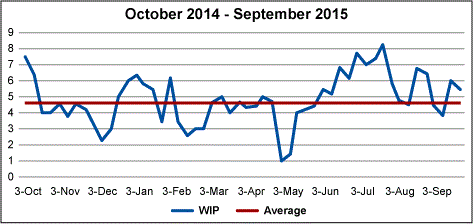
Additionally, the number of aircraft in LO restoration varied from one to nine during the same period. This variability provided a situation which made it difficult to project manpower and resource requirements on a daily basis. Given the small fleet of aircraft, this scheduling method reduced the AA rate from 100 percent to 75 percent just for scheduled heavy LO restoration. Additionally, to fulfill programmed depot maintenance (PDM) and contracted technology modification requirements the AA rate dwindled to 60 percent as three more aircraft were unavailable. This situation left only 12 aircraft to complete a 6,000+ hour per year FHP contract, contend with unscheduled maintenance, and a 24/7/365 strategic deterrence posture.
To combat the unpredictability of heavy LO restoration, Little’s Law was applied to the scheduling process. Little’s Law (as adapted by the Air Force Services Corporation) states that work in progress (WIP) = throughput x flowtime. In the case of heavy LO restoration, it was determined through flying schedule analysis that an appropriate WIP for LO restoration would be three aircraft, increasing AA 10 percent or by two additional aircraft available for use in the flying schedule. Using a WIP of three as the customer requirement and a throughput (Takt time) of one aircraft input every seven work days, the flowtime requirement equates to 21 days. Figure 2 depicts Little’s Law applied to the LO production machine (LOPM). Once the framework of the production machine was developed the focus became reducing the variable current state throughput of 18 to 45 days to a consistent 21 days.
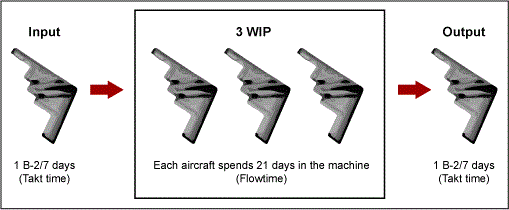
LO Restoration CPI Event
The application of Little’s Law spawned several issues that needed to be addressed before the LOPM could be launched. Most importantly, the 21-day flowtime requirement suggested that the entire LO restoration process required attention to reduce waste and build a critical path. In order to accomplish this feat, a CPI event was called. Team members for the event included subject matter experts (SMEs), senior leaders and customers from throughout the 509th MXG. The event was led by an Air Force CPI Black Belt and facilitated by the authors of this text. The event followed the Air Force CPI 8-step problem-solving model:
- Clarify and validate the problem.
- Break down the problem/identify performance gaps.
- Set improvement target.
- Determine root cause.
- Develop countermeasures.
- See countermeasures through.
- Confirm results and process.
- Standardize successful processes.
Step 1: Clarify and Validate the Problem
To clarify and validate the problem, the team brainstormed what needed to be accomplished during the CPI event. The first task was to fully understand what was expected of Whiteman AFB in the context of carrying out mission requirements. This was stated in the form of a question: “How do we balance combat commitments with the flying hour program?” Once they had a basic understanding of what the requirements were, the team could begin to formulate a quantifiable problem statement and goal(s) that would guide them to ultimate realization of their process. Tools used during formulation of the problem statement were brainstorming, value stream mapping and a SIPOC (supplier, inputs, process, outputs, customer) analysis.
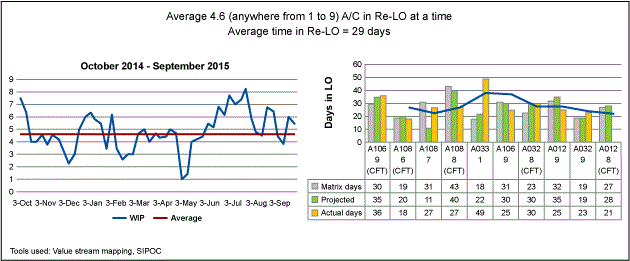
Problem statement: The 509th MXG averaged 4.6 aircraft WIP, ranging from one to nine aircraft WIP for heavy LO restoration. On average, 25 days were required to correct 140 defects. There is no standardized trigger point for heavy LO restoration induction. Goal: Maintain three scheduled aircraft WIP in heavy LO restoration while accomplishing 140 jobs in 21 days and maintaining the appropriate strategic deterrence posture.
Step 2: Break Down the Problem/Identify Performance Gaps
During the CPI event, the team spent the majority of its time collaborating in this step to understand where potential waste elimination opportunities existed in order to reduce flowtime to 21 days. The entire heavy LO restoration process was mapped using current state mapping to see and understand the process as it existed. As the team progressed through current state mapping, it was also able to identify improvement areas as each process step was labeled: 1) value added, 2) non-value added or 3) non-value added but required. Aside from creating a visual model of the current process, the value stream mapping exercise offered an opportunity to understand motivations and requirements of the many outside agencies that are involved in the LO restoration process. Tools used in this step were current state mapping and a gap analysis. It was determined that the process was hindered by overproduction, waste in motion, and waste in waiting. Figure 4 depicts the results of Step 2.
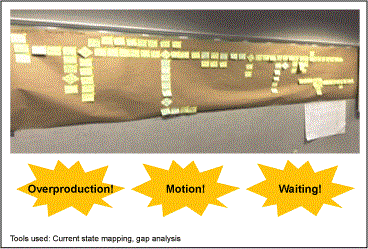
Step 3: Set Improvement Target
Once the problem was dissected into value added and non-value added activities, it was time to focus the creative minds of the team to understand what the LO production machine should resemble. Step 2 was easy to execute because of the vision, goals and problems presented to the team in Step 1 – three aircraft WIP with 21-day flowtime and seven-day Takt time. The team’s mission at this point was to execute the vision and design a functioning, maintainable machine focused on eliminating waste in the process. In order to do so, ideal state mapping and future state value stream mapping techniques were employed to direct the team toward a creative goal and provide a measurable indication of waste elimination. Once the team mapped the desired future state it was clear a closer look at manpower distribution was required since a consistent workload would be presented to them every seven days.
Once a detailed manpower study was completed, the team realized it had provided a source of waste as it mandated 24/7 coverage; a large portion of manpower was reserved to smaller weekend shifts. By adjusting manning requirements to accommodate a Monday through Friday shift schedule it became evident that a specific (consistent) number of personnel must be available per shift and per aircraft to make the LO production machine a reality. As a result, it was decided to eliminate the weekend duty team and absorb them into the new process. The team was able to increase workload on each of the three aircraft to push an aircraft out of the machine at the 21-day mark. Tools used in this step were ideal state mapping, future state mapping, SMART (specific, measurable, attainable, results focused, time bound) objectives and course of action (COA) analysis. Figure 5 depicts the results of Step 4.
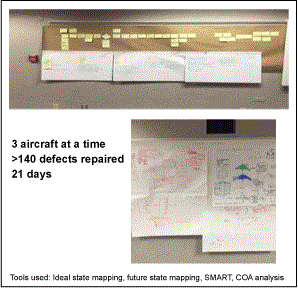
Step 4: Determine Root Cause
Step 4 was when the challenge began – determining the root cause. In order to understand if the team had addressed the source(s) of the problem it would need quantifiable measures to verify it was on the right track. This is an important step because the team needed something to base its corrective measures from. (A person must understand the root cause to be able to measure success after implementation of the goal.) Once again, brainstorming and Pareto analysis led the team to form a common understanding of the problem while the 5 Whys led them to dig deeper into the issues. As a result, the team determined the root causes to be lack of communication/planning, poor scheduling, lack of support and personnel management. The tools used to determine root cause(s) were current state mapping, brainstorming, affinity diagrams, 5 Whys, and a Pareto chart. Figure 6 depicts the results.
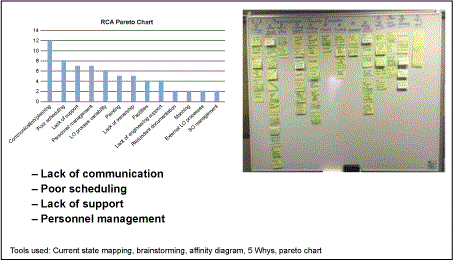
Part 2 of this case study looks at steps 5 through 8 of the continuous process improvement approach.